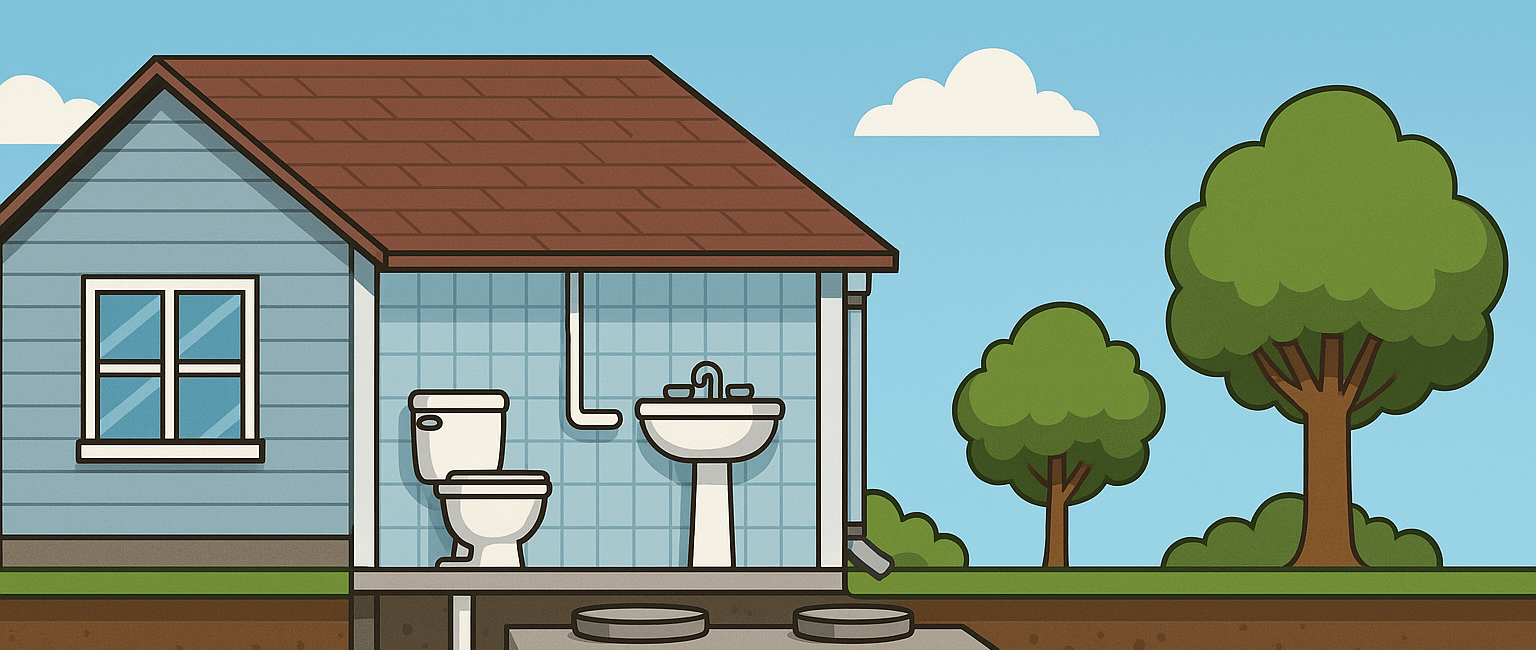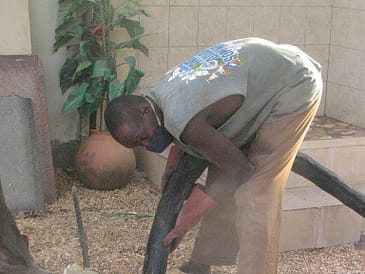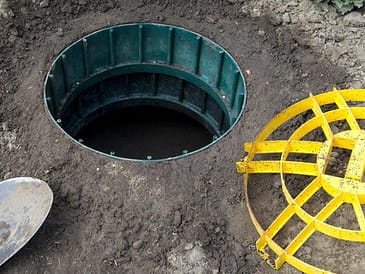If you’ve just moved into a home with a septic system—or never really thought about what happens after you flush—this guide is for you. Understanding how your septic tank works helps you avoid clogs, backups, and costly repairs down the road.
What Is a Septic System?
A septic system is an underground wastewater treatment structure that’s typically used in rural or suburban areas where municipal sewer systems aren’t available. It safely processes and disperses household wastewater on your property through natural decomposition and soil filtration.
The Essential Components of Your Septic System
Understanding the main parts of your septic system will help you better maintain this crucial home infrastructure:
The Septic Tank
The septic tank is a watertight underground container typically made of concrete, fiberglass, or polyethylene. Modern tanks usually have a 1,000-1,500 gallon capacity for average homes. This container temporarily holds all wastewater from your household, allowing time for solid and liquid waste to separate.
Inlet and Outlet Pipes
The inlet pipe carries all wastewater from your home into the septic tank. The outlet pipe (sometimes called the drain pipe) features a T-shaped design that allows only the clarified liquid to exit the tank while keeping solids and floating materials inside.
Drain Field (Leach Field)
The drain field consists of a network of perforated pipes laid in gravel-filled trenches or beds. This area is where the final wastewater treatment occurs as effluent filters through the soil. A properly functioning drain field is essential for preventing groundwater contamination.
Distribution Box
In many systems, a distribution box evenly divides the flow of wastewater from the septic tank to the various drain field pipes, ensuring the entire drain field is utilized effectively.
“The soil in your drain field does the real heavy lifting in your septic system,” explains Dr. Sara Waters, environmental engineer and wastewater treatment specialist. “It’s nature’s perfect filter, removing harmful bacteria and nutrients before the water returns to the groundwater system.”
The Septic Process: What Happens After You Flush
Your septic system works through a carefully balanced biological process that breaks down waste naturally:
Step 1: Wastewater Collection
Everything that goes down your drains—from toilets, showers, sinks, washing machines, and dishwashers—flows through your home’s plumbing into the septic tank. This wastewater contains both dissolved and solid materials.
Step 2: Separation in the Tank
Inside the septic tank, three distinct layers form:
- Scum layer: Oils, greases, and lighter materials float to the top
- Effluent layer: Relatively clear liquid wastewater forms the middle layer
- Sludge layer: Heavier solids settle to the bottom of the tank
Step 3: Bacterial Decomposition
Naturally occurring anaerobic bacteria (bacteria that thrive without oxygen) begin breaking down the organic material in both the sludge and scum layers. This biological process reduces the volume of solids and converts some materials into liquid and gases.
Step 4: Effluent Distribution
The clarified liquid effluent from the middle layer flows through the outlet pipe and into the distribution box, which evenly distributes it throughout the drain field pipes. The T-shaped outlet prevents floating scum and settled sludge from leaving the tank.
Step 5: Soil Filtration and Treatment
As the effluent percolates through the gravel and soil in the drain field, several important processes occur:
- Harmful bacteria are removed through natural filtration
- Nutrients are absorbed by soil particles and plant roots
- Aerobic bacteria (which require oxygen) in the soil provide additional treatment
- The clean, treated water eventually returns to the groundwater table
Signs Your Septic System Needs Attention
Being aware of potential problems can help you address issues before they become expensive emergencies:
- Slow-draining sinks or toilets throughout the house
- Gurgling sounds in plumbing system
- Sewage odors indoors or around your yard
- Unusually lush, green grass over the drain field area
- Pooling water or soggy soil around the septic tank or drain field
- Sewage backing up into household drains
- High nitrate or bacteria levels in your well water tests
Essential Maintenance for Long-Term Septic Health
Proper maintenance is crucial for keeping your septic system functioning effectively for decades:
Regular Pumping Schedule
Most residential septic tanks need pumping every 3-5 years, depending on household size and water usage. During pumping, a professional removes the accumulated sludge and scum that bacteria can’t fully decompose. Skipping this crucial maintenance can lead to system failure.
Mindful Water Usage
Your septic system processes a finite amount of water. Consider these water conservation tips:
- Spread out laundry loads throughout the week rather than doing all loads in one day
- Install high-efficiency toilets and water-saving fixtures
- Fix leaky faucets and running toilets promptly
- Direct roof drains and sump pumps away from the drain field area
Proper Waste Disposal
What goes down your drains directly impacts your septic system’s health:
- Never flush “flushable” wipes, feminine hygiene products, paper towels, or other non-degradable items
- Avoid pouring grease, oil, or fat down kitchen drains
- Don’t use your toilet as a trash can for dental floss, cigarette butts, or medication
- Limit garbage disposal use, as it increases solid waste in your system
Drain Field Protection
The drain field is particularly vulnerable to damage:
- Never park or drive vehicles over the drain field area
- Avoid planting trees or shrubs near the drain field, as roots can damage pipes
- Don’t build structures, patios, or swimming pools over any part of your septic system
- Keep roof drains, sump pumps, and other rainwater drainage systems away from the drain field
Careful Chemical Use
Many household chemicals can disrupt the bacterial balance in your tank:
- Avoid excessive use of antibacterial soaps and cleaners
- Never pour paint, solvents, oils, pesticides, or other harsh chemicals down drains
- Use septic-safe cleaning products whenever possible
- Limit the use of drain cleaners, which can kill beneficial bacteria
Understanding Your Septic System’s Lifespan
With proper care and maintenance, most septic systems can last 25-30 years or longer. However, several factors influence longevity:
- Installation quality and materials used
- Household size and water usage patterns
- Soil quality and drainage characteristics
- Maintenance frequency and thoroughness
- Climate and groundwater conditions
When to Call a Professional
Some septic situations require expert help. Contact a licensed septic professional if you notice:
- Multiple slow or backed-up drains
- Standing water over your drain field
- Sewage odors inside or outside your home
- Lush, green grass over the drain field when the rest of your lawn is dry
- Gurgling sounds in your plumbing system
The Bottom Line for Homeowners
Your septic system provides essential wastewater treatment for your home. By understanding how it works and providing proper maintenance, you can avoid costly repairs and ensure it functions effectively for decades.
Remember that prevention is always less expensive than repair. Establishing good habits now—regular pumping, careful water usage, and proper waste disposal—will help maintain your system’s health and protect both your property investment and the environment.
For more information about caring for your septic system, consider scheduling an inspection with a licensed septic professional who can provide personalized advice for your specific system and property conditions.





